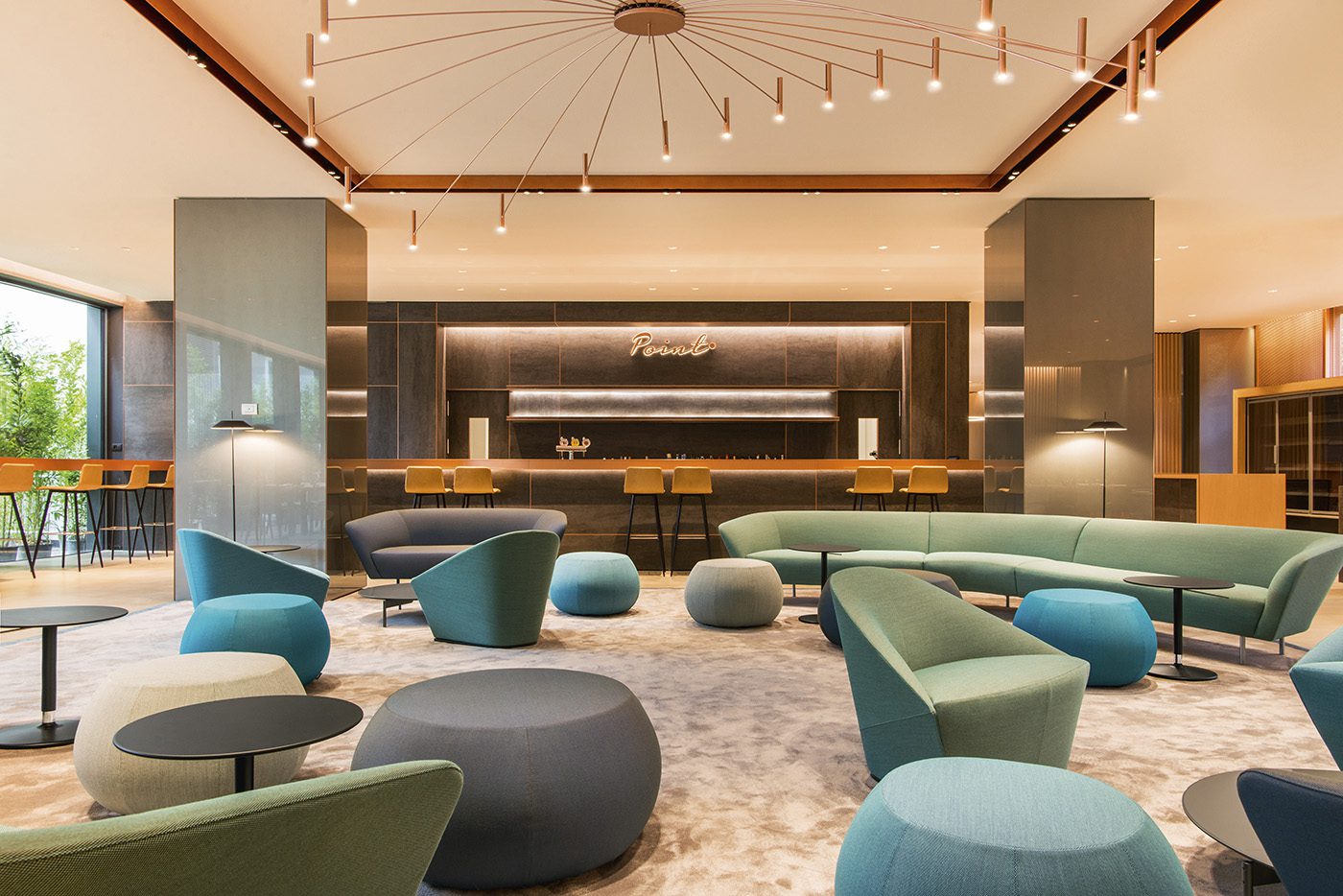In the world of hospitality, every detail matters when it comes to creating an exceptional guest experience. From the moment guests step into a hotel, the ambiance and design play a crucial role in shaping their overall impression. Among the key elements of hotel design, furniture is a powerful tool to convey style, comfort, and functionality. It enhances the space’s aesthetics and enhances guests’ satisfaction and comfort.
This blog aims to delve into the captivating world of hotel furniture design, uncovering the latest trends and concepts that shape the industry. By examining the evolution of hotel furniture design, exploring current trends, and providing practical insights, hoteliers and interior designers can gain inspiration and knowledge to create memorable spaces that leave a lasting impact on their guests.
Evolution of Hotel Furniture Design
A. Historical overview of hotel furniture styles and trends
To truly appreciate the current trends in hotel furniture design, it is essential to understand the historical evolution of this field. Hotel furniture has undergone various stylistic shifts over the years, influenced by changing design movements, architectural trends, and societal preferences. From the opulent and grand furniture of the Victorian era to the sleek and minimalistic designs of the mid-century modern movement, each period has left its mark on hotel furniture design.
B. Influence of architectural and interior design movements on hotel furniture
The relationship between architectural and interior design movements and hotel furniture design is symbiotic. Architectural styles, such as Art Deco, Bauhaus, or Postmodernism, have influenced the overall design language and subsequently impacted the choice of furniture in hotels. The interplay between these disciplines has resulted in unique combinations of form, materials, and functionality, creating distinct atmospheres and experiences for hotel guests.
Current Trends in Hotel Furniture Design
A. Emphasis on sustainability and eco-friendly materials
With the growing awareness of environmental concerns, sustainability has become a significant consideration in hotel furniture design. Designers increasingly opt for eco-friendly materials and production methods, such as reclaimed wood, recycled plastics, or organic textiles. By integrating sustainable practices, hotels can align themselves with the values of environmentally conscious guests while showcasing their commitment to responsible design.
B. Integration of technology in furniture design for enhanced guest experience
Technology’s integration into hotel furniture design has become a game-changer as technology advances. From smart beds that adjust to individual preferences to charging stations seamlessly incorporated into bedside tables, technology-enhanced furniture provides convenience and comfort to guests. By blending functionality and innovation, hotels can offer a seamless and personalized experience that caters to the needs of modern travelers.
C. Incorporation of modular and multifunctional furniture for space optimization
Space optimization is crucial to hotel design, especially in urban environments where square footage is often limited. Modular and multifunctional furniture has gained popularity due to its ability to adapt to different layouts and purposes. Foldable tables, expandable sofas, and storage-integrated designs maximize the functionality of the space, allowing hotels to create versatile and efficient guest rooms.
D. Exploration of unique and unconventional materials and textures
To create captivating and unique atmospheres, hotel furniture designers push the boundaries of creativity by experimenting with unconventional materials and textures. From handcrafted artisanal pieces to furniture adorned with natural elements like shells or feathers, these distinctive design elements add an element of surprise and delight, leaving a lasting impression on guests.
Contemporary Hotel Furniture Concepts
A. Minimalist and Scandinavian-inspired designs for a clean and serene ambiance
The minimalist and Scandinavian design movements have strongly influenced the contemporary hotel furniture landscape. Characterized by simplicity, clean lines, and a focus on functionality, these design approaches create a serene and clutter-free ambiance. Light-colored woods, neutral tones, and uncluttered spaces evoke a sense of calm and sophistication, providing guests with a retreat from the chaos of everyday life.
B. Bohemian and eclectic styles for a vibrant and personalized atmosphere
For hotels aiming to create a vibrant and personalized atmosphere, bohemian and eclectic styles offer an exciting avenue for exploration. Mixing patterns, colors, and textures, these designs celebrate individuality and self-expression. With an array of vintage furniture, ethnic prints, and diverse textures, these spaces invite guests to immerse themselves in a world of artistic expression and cultural diversity.
C. Industrial and rustic aesthetics for a modern and cozy feel
Industrial and rustic aesthetics have gained popularity for their ability to infuse spaces with a modern and cozy feel. Exposed brick walls, distressed wood finishes, and vintage-inspired furniture create a sense of nostalgia and warmth. Combining these elements with contemporary design accents allows hotels to balance comfort and a raw, urban edge, appealing to guests seeking a unique and authentic experience.
D. Luxurious and opulent furniture designs for high-end establishments
For luxury hotels, opulent furniture designs create a sense of grandeur and elegance. Extravagant materials, such as marble, velvet, or gold accents, adorn the furniture, exuding a lavish and sophisticated aura. From intricately carved headboards to chandeliers suspended above luxurious dining tables, these designs cater to the desires of high-end clientele who seek indulgence and exclusivity.
Case Studies: Notable Hotel Furniture Design Projects
A. Showcase of hotels with innovative and trendsetting furniture designs
Examining real-life examples of hotels with innovative furniture designs can inspire industry professionals to think outside the box. Case studies of establishments that have successfully integrated unique furniture concepts and materials can provide insights into the execution and impact of these designs. By analyzing the design concepts, materials used, and guest feedback, one can understand the factors contributing to such projects’ success.
B. Analysis of the design concepts, materials used, and guest feedback
An in-depth analysis of the design concepts, materials used, and guest feedback enables a comprehensive understanding of the influence and effectiveness of hotel furniture design. By examining the guest experience and reactions to specific furniture elements, hoteliers and designers can refine their approach and make informed decisions when selecting and implementing new designs.
Future Directions in Hotel Furniture Design
A. Predictions and emerging concepts in hotel furniture design
The world of hotel furniture design is ever-evolving, with new concepts and trends continually emerging. Predictions and insights into the future of this field provide valuable foresight for hoteliers and designers. By staying informed about upcoming trends, they can proactively adapt their strategies and stay ahead of the curve, offering guests fresh and innovative experiences.
B. Impact of technology advancements on future furniture trends
Technology’s impact on future furniture trends must be noticed as it advances exponentially. From interactive surfaces and augmented reality to innovative materials and sustainable innovations, technology will play a pivotal role in shaping the future of hotel furniture design. By embracing these advancements, hotels can create immersive environments that captivate guests and provide seamless interactions.
C. Integration of sustainability and wellness concepts in future designs
Integrating sustainability and wellness concepts into future hotel furniture designs is inevitable in an era of heightened environmental awareness and wellness-focused lifestyles. Hotels prioritizing sustainable materials, energy-efficient solutions, and wellness-enhancing features will cater to the growing demand for eco-conscious and health-oriented experiences. Embracing these concepts benefits the planet and resonates with guests seeking holistic well-being during their stay.
Expert Interviews: Insights from Furniture Designers and Industry Professionals
A. Interviews with renowned furniture designers and manufacturers
Gaining insights from renowned furniture designers and manufacturers provides valuable perspectives on the industry. By interviewing these experts, one can uncover their inspirations, design philosophies, and predictions for future trends. Their wealth of experience and knowledge can guide hoteliers and designers in making informed decisions, infusing their projects with creativity and expertise.
B. Discussion of their inspirations, design philosophies, and predictions for future trends
Engaging in discussions with furniture designers and industry professionals allows for a deeper understanding of their inspirations, design philosophies, and predictions for future trends. By exploring the driving forces behind their work, professionals in the hospitality industry can gain valuable insights and inspiration to guide their creative processes. These conversations foster collaboration and mutual learning within the design community.
Practical Tips for Hoteliers and Interior Designers
A. Guidance on selecting and sourcing hotel furniture based on specific design concepts
Selecting the right furniture for a hotel requires careful consideration of the design concept, target audience, and desired guest experience. Practical tips on identifying and sourcing furniture that aligns with specific design concepts can help hoteliers and interior designers make informed choices. From understanding different materials and finishes to considering durability and functionality, these guidelines ensure that the furniture seamlessly integrates into the overall design vision.
B. Considerations for functionality, durability, and maintenance of hotel furniture
In addition to aesthetics, functionality, durability, and maintenance are critical factors to consider when selecting hotel furniture. Practical advice on choosing furniture that can withstand the demands of high occupancy, regular use, and varying guest preferences ensures long-lasting investments. Understanding the maintenance requirements and lifespan of different materials aids in decision-making, allowing hoteliers to optimize their budget and maintain the quality of the furniture over time.
C. Advice on creating cohesive and visually appealing furniture arrangements
Creating cohesive and visually appealing furniture arrangements is vital to curating inviting and harmonious spaces. Tips on spatial planning, furniture placement, and creating focal points help hoteliers and interior designers optimize the layout of guest rooms, lobbies, and common areas. By considering the flow of movement, the balance of proportions, and the interplay of colors and textures, they can create visually striking environments that captivate guests.
Conclusion
In conclusion, embracing innovation and creativity in hotel interior design is crucial to staying relevant in a competitive industry. By following the latest trends, seeking inspiration from experts, and infusing spaces with unique and memorable furniture designs, hoteliers and interior designers can create extraordinary guest experiences that leave a lasting impression. Throughout this article, we have explored the latest trends and concepts in hotel furniture design. From the emphasis on sustainability and technology integration to the exploration of diverse styles and materials, the world of hotel furniture is constantly evolving to meet guests’ ever-changing needs and preferences.












